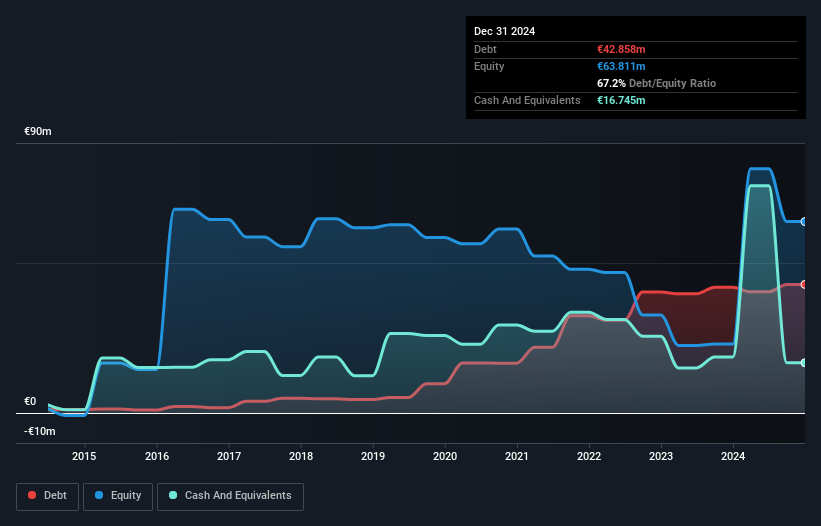We Think OSE Immunotherapeutics (EPA:OSE) Can Stay On Top Of Its Debt
Legendary fund manager Li Lu (who Charlie Munger backed) once said, 'The biggest investment risk is not the volatility of prices, but whether you will suffer a permanent loss of capital.' So it might be obvious that you need to consider debt, when you think about how risky any given stock is, because too much debt can sink a company. As with many other companies OSE Immunotherapeutics SA (EPA:OSE) makes use of debt. But the real question is whether this debt is making the company risky.
When Is Debt A Problem?
Debt and other liabilities become risky for a business when it cannot easily fulfill those obligations, either with free cash flow or by raising capital at an attractive price. Ultimately, if the company can't fulfill its legal obligations to repay debt, shareholders could walk away with nothing. While that is not too common, we often do see indebted companies permanently diluting shareholders because lenders force them to raise capital at a distressed price. By replacing dilution, though, debt can be an extremely good tool for businesses that need capital to invest in growth at high rates of return. The first step when considering a company's debt levels is to consider its cash and debt together.
What Is OSE Immunotherapeutics's Debt?
The chart below, which you can click on for greater detail, shows that OSE Immunotherapeutics had €42.9m in debt in December 2024; about the same as the year before. However, it also had €16.7m in cash, and so its net debt is €26.1m.

How Strong Is OSE Immunotherapeutics' Balance Sheet?
Zooming in on the latest balance sheet data, we can see that OSE Immunotherapeutics had liabilities of €20.2m due within 12 months and liabilities of €39.9m due beyond that. Offsetting these obligations, it had cash of €16.7m as well as receivables valued at €4.14m due within 12 months. So it has liabilities totalling €39.3m more than its cash and near-term receivables, combined.
OSE Immunotherapeutics has a market capitalization of €120.5m, so it could very likely raise cash to ameliorate its balance sheet, if the need arose. But we definitely want to keep our eyes open to indications that its debt is bringing too much risk.
View our latest analysis for OSE Immunotherapeutics
In order to size up a company's debt relative to its earnings, we calculate its net debt divided by its earnings before interest, tax, depreciation, and amortization (EBITDA) and its earnings before interest and tax (EBIT) divided by its interest expense (its interest cover). Thus we consider debt relative to earnings both with and without depreciation and amortization expenses.
OSE Immunotherapeutics's net debt is only 0.53 times its EBITDA. And its EBIT covers its interest expense a whopping 11.2 times over. So you could argue it is no more threatened by its debt than an elephant is by a mouse. It was also good to see that despite losing money on the EBIT line last year, OSE Immunotherapeutics turned things around in the last 12 months, delivering and EBIT of €44m. There's no doubt that we learn most about debt from the balance sheet. But it is future earnings, more than anything, that will determine OSE Immunotherapeutics's ability to maintain a healthy balance sheet going forward. So if you're focused on the future you can check out this free report showing analyst profit forecasts .
Finally, a company can only pay off debt with cold hard cash, not accounting profits. So it is important to check how much of its earnings before interest and tax (EBIT) converts to actual free cash flow. Over the last year, OSE Immunotherapeutics actually produced more free cash flow than EBIT. There's nothing better than incoming cash when it comes to staying in your lenders' good graces.
Our View
Happily, OSE Immunotherapeutics's impressive conversion of EBIT to free cash flow implies it has the upper hand on its debt. And the good news does not stop there, as its interest cover also supports that impression! When we consider the range of factors above, it looks like OSE Immunotherapeutics is pretty sensible with its use of debt. While that brings some risk, it can also enhance returns for shareholders. There's no doubt that we learn most about debt from the balance sheet. However, not all investment risk resides within the balance sheet - far from it. Case in point: We've spotted 3 warning signs for OSE Immunotherapeutics you should be aware of, and 1 of them is concerning.
Of course, if you're the type of investor who prefers buying stocks without the burden of debt, then don't hesitate to discover our exclusive list of net cash growth stocks, today.
New: AI Stock Screener & Alerts
Our new AI Stock Screener scans the market every day to uncover opportunities.
• Dividend Powerhouses (3%+ Yield)
• Undervalued Small Caps with Insider Buying
• High growth Tech and AI Companies
Or build your own from over 50 metrics.
Have feedback on this article? Concerned about the content? Get in touch with us directly. Alternatively, email editorial-team (at) simplywallst.com.
This article by Simply Wall St is general in nature. We provide commentary based on historical data and analyst forecasts only using an unbiased methodology and our articles are not intended to be financial advice. It does not constitute a recommendation to buy or sell any stock, and does not take account of your objectives, or your financial situation. We aim to bring you long-term focused analysis driven by fundamental data. Note that our analysis may not factor in the latest price-sensitive company announcements or qualitative material. Simply Wall St has no position in any stocks mentioned.
About ENXTPA:OSE
OSE Immunotherapeutics
A clinical-stage biotechnology company, develops immunotherapies in the areas of immune-oncology and immune-inflammation in France and internationally.
Excellent balance sheet with proven track record.
Similar Companies
Market Insights
Community Narratives



